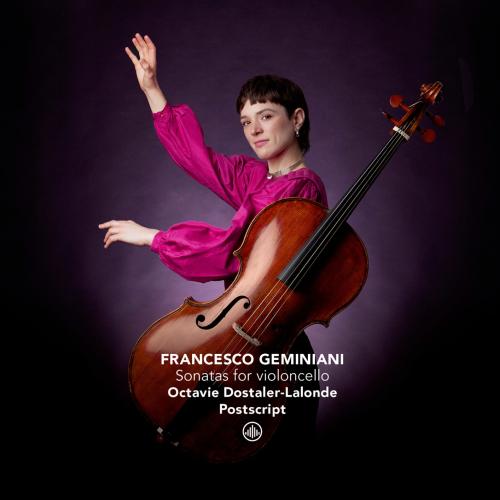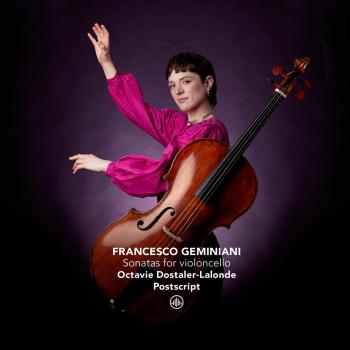
Geminiani : Sonatas for Violoncello Octavie Dostaler-Lalonde
Album info
Album-Release:
2024
HRA-Release:
18.10.2024
Label: Challenge Classics
Genre: Classical
Subgenre: Chamber Music
Artist: Octavie Dostaler-Lalonde
Composer: Francesco Geminiani (1687-1762)
Album including Album cover Booklet (PDF)
- Francesco Geminiani (1687 - 1762): Sonata for Cello and Basso Continuo, Op. 5 No. 2:
- 1 Geminiani: Sonata for Cello and Basso Continuo, Op. 5 No. 2: I. Andante 02:05
- 2 Geminiani: Sonata for Cello and Basso Continuo, Op. 5 No. 2: II. Presto 04:30
- 3 Geminiani: Sonata for Cello and Basso Continuo, Op. 5 No. 2: III. Adagio 03:02
- 4 Geminiani: Sonata for Cello and Basso Continuo, Op. 5 No. 2: IV. Allegro 01:40
- The Art of Playing the Guitar or Cittra (Arranged for Cello Piccolo and b.c.):
- 5 Geminiani: The Art of Playing the Guitar or Cittra (Arranged for Cello Piccolo and b.c.): Canon 04:26
- Sonata for Cello and Basso Continuo, Op. 5 No. 3:
- 6 Geminiani: Sonata for Cello and Basso Continuo, Op. 5 No. 3: I. Andante 02:50
- 7 Geminiani: Sonata for Cello and Basso Continuo, Op. 5 No. 3: II. Allegro 03:04
- 8 Geminiani: Sonata for Cello and Basso Continuo, Op. 5 No. 3: III. Affettuoso 02:05
- 9 Geminiani: Sonata for Cello and Basso Continuo, Op. 5 No. 3: IV. Allegro 02:32
- Sonata for two Violins and Continuo, Op. 1 No. 2 (Arranged for two Cello Piccolos):
- 10 Geminiani: Sonata for two Violins and Continuo, Op. 1 No. 2 (Arranged for two Cello Piccolos): I. Grave 02:33
- 11 Geminiani: Sonata for two Violins and Continuo, Op. 1 No. 2 (Arranged for two Cello Piccolos): II. Allegro - Adagio 00:46
- 12 Geminiani: Sonata for two Violins and Continuo, Op. 1 No. 2 (Arranged for two Cello Piccolos): III. Allegro 03:20
- The Art of Playing the Guitar or Cittra (Arranged for Cello Piccolo and b.c.):
- 13 Geminiani: The Art of Playing the Guitar or Cittra (Arranged for Cello Piccolo and b.c.): Affettuoso 02:20
- Sonata for Cello and Basso Continuo, Op. 5 No. 1:
- 14 Geminiani: Sonata for Cello and Basso Continuo, Op. 5 No. 1: I. Andante 01:35
- 15 Geminiani: Sonata for Cello and Basso Continuo, Op. 5 No. 1: II. Allegro 03:37
- 16 Geminiani: Sonata for Cello and Basso Continuo, Op. 5 No. 1: III. Andante 00:45
- 17 Geminiani: Sonata for Cello and Basso Continuo, Op. 5 No. 1: IV. Allegro 04:02
- Sonata for Cello and Basso Continuo, Op. 5 No. 6:
- 18 Geminiani: Sonata for Cello and Basso Continuo, Op. 5 No. 6: I. Adagio 00:38
- 19 Geminiani: Sonata for Cello and Basso Continuo, Op. 5 No. 6: II. Allegro assai - Grave 03:37
- 20 Geminiani: Sonata for Cello and Basso Continuo, Op. 5 No. 6: III. Allegro - Non tanto 04:11
Info for Geminiani : Sonatas for Violoncello
A unique album devoted to cello Galant music composed mid-18th Century in the areas of Mannheim and Berlin.
Octavie Dostaler-Lalonde: In 2018, I acquired a beautiful Baroque cello labeled J M Alban, fecit 17 a Graz. The instrument is of a smaller size than today's standard cello, and the sound is silky, malleable and rich. I had heard of the existence of four-string violoncello piccolos (tuned G-d-a-e') during the 17th and 18th centuries, and soon I decided to try this tuning on my small 18th-century cello. The result was impressive: the instrument's tone became bright, crystalline and colourful, with an enhanced singing quality on the top string. This new voice of the Alban was an exciting discovery, and I set my mind to recording a full programme featuring my four-string violoncello piccolo.
I first tried it in a lovely sonata for violoncello and continuo by Georg Czarth (which appears on this album), and found that the cello's tone displayed sweetness and elegance perfectly suited to German Galant music. I selected a number of works where the compass fitted this tuning, and narrowed the lot down after initial reading sessions with Artem Belogurov. I wanted to offer space on this album for his expressive playing and his Stein fortepiano, a copy made by Gerard Tuinman, so I included two pieces for obbligato cello and fortepiano, where the piano has a central role.
The Stein has an action with hammers made of uncovered wooden rings, instead of the leather-covered hammers more commonly heard today: when wooden hammers strike the metal strings directly, they produce a uniquely brilliant and sparkling tone in forte passages, and a gentle cantabile sound when played softly. By engaging the moderator (a piece of felt that lies between the strings and the hammers), Artem introduces an entirely contrasting sound world, perfectly suited for adagios and intimate, delicate passages in an Emfindsamer Stil.
"The sonatas are in three movements and embody the elegance, intimacy, and emotional sensitivity of the Empfindsamer Stil. Dostaler-Lalonde plays them exquisitely, with a beguiling lyrical tone quality, elegant phrasing, and flawless technique. (...) The satisfaction provided by the performances of Dostaler-Lalonde and Belogurov (and cellist Victor García García in the Benda and Zyka works) is augmented by their introduction of ornamentation, portamento, and flexibility of melodic phrasing over a regulated accompaniment. All of the elements lend the music-making a freshness, spontaneity, and sense of freedom that do not diminish over repeated hearings. The recorded sound is marvelous. Dostaler-Lalonde's liner notes are of considerable value as well. Recommended." (Fanfare Magazine)
Octavie Dostaler-Lalonde, piccolo cello
Artem Belogurov, fortepiano
Victor Garcia Garcia, cello
Octavie Dostaler-Lalonde
is a versatile musician whose repertoire ranges from the late-17th to the 20th century. She researches and uses techniques and instruments according to the time of the music she plays.
After studying modern cello with Denis Brott and Carole Sirois at the Conservatoire de Musique de Montréal, Octavie received the Prix avec Grande Distinction in 2011. Following her interest in performance practice, she studied baroque cello with Susie Napper in Montreal and with Viola de Hoog in Amsterdam. As a young musician, Octavie regularly won prizes in national competitions in Quebec and Canada and regularly attended masterclasses and courses with internationally renowned soloists and pedagogues. She received prizes as a soloist at the International Competition “Concours Corneille” in France and the Early Music Competition in Yamanashi, Japan. Her musical endeavors were supported by grants from the Canada Arts Council, the Banff Center for the Arts and the CALQ.
Currently focusing on the historical performance of late Baroque, Classical and Romantic repertoires, she performs recitals regularly with fortepiano player and harpsichordist Artem Belogurov. Together, they took part in the Oude Muziek Festival Utrecht, Festival Montreal Baroque, the International Young Artist Presentation in Antwerp, Festival Royaumont, the Fortepiano Festival Zaandijk, among others. Their first CD will be issued later this year on the label Challenge Classics and is centered around mid-18th century German music for violoncello piccolo.
In Europe, she regularly performs with groups such as Ensemble Masques, Vox Luminis, La Sfera Armoniosa, Il Gardellino, Orchestra of the 18th century, and the Nieuwe Philharmonie Utrecht. She was selected for the 2017 Experience Scheme with the Orchestra of the Age of Enlightenment, the Handel House Talent 2018-2019 and the Monteverdi Apprenticeship 2019-2020. An avid chamber musician, she co-founded the period ensemble Postscript, which has performed during Oude Muziek Festival Utrecht and MA Festival Brugge, among others. While still in Montreal, Octavie performed with many ensembles including the Montreal Symphony Orchestra, Ensemble Caprice, les Rendez-vous baroque français, Les Lys Naissants and the chamber groups Epsilon, quintette à cordes, Ensemble Arkea, Ensemble Allogène, Ensemble Paramirabo and the Ensemble BOP. Her recordings can be heard on labels such as Alpha Classics, Passacaille, Challenge Classics, Brilliant Classics and TRPTK.
She was the co-director of Romberg Dagen, a festival celebrating the composer and cellist Bernhard Romberg and the performance of 19th-century music, which took place in Amsterdam in May 2018. Her current research is centered on the performance practice of late 19th and early 20th century through the imitation of early recordings: these experiments are explored on the Romantic Lab blog.
Octavie has the pleasure of playing a Thomas Dodd cello from 1800 on loan from the Nationaal Muziekinstrumenten Fonds of the Netherlands, as well as her own ca.1700 baroque cello by Johann Michael Alban.
Artem Belogurov
Known equally for his “verve, wit, and delicatesse” (Boston Musical Intelligencer) and his “infinite tenderness” (Evening Odessa), Artem Belogurov has an extensive repertoire, ranging through three centuries of solo and chamber works. He has a particular affinity for the Viennese classical style, in which he is distinguished by his use of improvisatory ornamentation. His interest in period performance leads him to historical keyboards, including clavichord, harpsichord, and fortepianos spanning the eighteenth and nineteenth centuries. His critically acclaimed album of solo piano works by the late nineteenth century American Romantic composers, recorded on a Chickering piano built in 1873, was released by the London-based label Piano Classics in 2015. He is also a discerning advocate of contemporary music, and collaborates with a number of composers. In 2009 he had the honor of performing the Boston premiere of Elliott Carter’s Caténaires for solo piano.
As a soloist and in chamber groups, Artem has performed in a wide variety of venues, among them Jordan Hall, Harvard Musical Association, the Universität der Kunste in Berlin, the Musikhochschule in Hanover, St Andrews University in Scotland, the Odessa Philharmonic Hall in Ukraine, the Rachmaninoff Society in Saint Petersburg, Castello di Galeazza in Italy, Tivoli Vredenburg in Utrecht, and Muziekgebouw in Amsterdam.
Artem’s recent projects included a series of lectures, recitals, and masterclasses in Germany on the Chopin Préludes with the noted musicologist and historian Mark Lindley, US tours with the brilliant young Ukrainian violinist, Aleksey Semenenko, and performances at the Early Music Festival Fabulous Fringe in Utrecht. He has also been performing programs drawn from his solo CD in the US and Europe. His recording of a new arrangement of Prokofiev’s opera Fiery Angel for cello and piano with the Russian cellist Maya Fridman on the label TRPTK is scheduled to be released in Fall 2016. His next recording projects include Beethoven’s complete works for fortepiano and cello on original instruments with the Canadian cellist Octavie Dostaler-Lalonde, for the Italian label Gamma Musica and a CD of violin and piano music by composers from Boston with Aleksey Semenenko. In the coming season, Artem will be touring Europe, the US, and Japan.
In April 2016, Artem was awarded second prize at the 29th International Competition for Early Music in Yamanashi, Japan. Artem received his Bachelor degree in Piano Performance from the New England Conservatory where his teachers were Gabriel Chodos, Patricia Zander, and Victor Rosenbaum. In 2016 he graduated from the Master of Music in Early Keyboards program at the Conservatorium van Amsterdam and received cum laude in both clavichord and fortepiano. His main teachers were Menno van Delft, Richard Egarr, and Kris Verhelst.
Victor Garcia Garcia
is a Spanish cellist specialized in historical performance. He enjoys a varied and international musical career as a soloist, teacher, chamber musician and orchestral player. He teaches historical cello at the Utrechts Conservatorium, and was recently awarded a doctoral degree at the Royal Conservatoire of Scotland. His artistic research focused on the performance practices of cellists around Beethoven. Victor is a prizewinner at the Witold Lutoslawski Cello Competition, the Händel Competition (as part of the Duo Auxesis) and the Biagio Marini Competition (as part of Ayres Extemporae). Additionally, he has been an Artist in Residence at the Schloss Weissenbrunn. Victor has participated in the Monteverdi Apprentices Programme at the Orchestre Révolutionnaire et Romantique, the Collegium Vocale Gent Academy and the Academy of the Balthasar Neumann Ensembles. He also performs regularly with ensembles such as the Orchestre des Champs- Élysées, the Utopia Orchestra and the Millenium Orchestra. He is the artistic director of the Festival Impulso in La Palma, Spain.
Booklet for Geminiani : Sonatas for Violoncello










